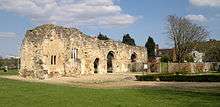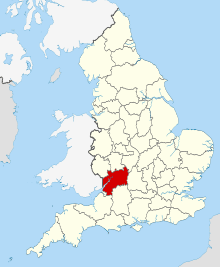St Oswald's Priory, Gloucester
St Oswald's Priory was founded by Æthelflæd, daughter of Alfred the Great, and her husband Æthelred, ealdorman of Mercia, in the late 880s or the 890s.[1][2]



St Peter's Abbey had been founded in Gloucester about 679 by Osric, ruler of the Hwicce, and at the end of the ninth century Æthelflæd and Æthelred founded a new minster at a different location in Gloucester, also initially dedicated to St Peter. In 909 a combined West Saxon and Mercian raid into Danish territory resulted in the translation of the bones of St Oswald to the new church from Bardney Abbey in Lincolnshire, and the priory was renamed St Oswald's in his honour.[2][3]
St Oswald's, founded when Gloucester was an important new burh, at first enjoyed royal favour, and both Æthelflæd and Æthelred were buried there. Æthelflæd's nephew, the future King Æthelstan, was brought up at their court, and according to a charter only preserved in a transcript dating from 1304, in 925 Æthelstan granted privileges to St Oswald's "according to a pact of paternal piety which formerly he pledged with Æthelred".[4] Æthelstan was a major benefactor of St Oswald's, and he may have commissioned grave covers for the tombs of Æthelflæd and Æthelred.[5]
However, the priory soon declined into obscurity. Late in the reign of King Cnut its estates were used as an endowment for a royal clerk. In 1089 Serlo, the Norman abbot of the original St Peter's, began an ambitious new church (later Gloucester Cathedral) to replace the old minster, and St Oswald's, its emoluments much reduced, became a minor house of Augustinian canons.[6] The monastery was suppressed in 1536, and became the parish church of St Catherine, but this was destroyed in a Civil War siege in 1643.[2]
It is a Grade I listed building, located at Priory Road, Gloucester GL1 2RF.[7]
Items from the priory are in Gloucester City Museum & Art Gallery.
Citations
- Heighway, p. 103
- St Oswald's Priory, English Heritage
- Heighway, pp. 102-103
- Foot, pp. 34, 206
- Karkov, pp. 77–79
- Heighway, p. 110
- St Oswald's Priory, British Listed Buildings
Sources
- Foot, Sarah (2011). Æthelstan: The First King of England. New Haven and London: Yale University Press. ISBN 978-0-300-12535-1.
- Heighway, Carolyn (2001). "Gloucester and the new minster of St Oswald". In Higham, N. J.; Hill, D. H. (eds.). Edward the Elder 899-924. Routledge. ISBN 0-415-21497-1.
- Karkov, Catherine E. (2004). The Ruler Portraits of Anglo-Saxon England. The Boydell Press. ISBN 1-84383-059-0.
- Historic England. "St Oswalds Priory (1119912)". PastScape. Retrieved 23 February 2011.
- "St Oswald's Priory, Gloucester". British Listed Buildings. Retrieved 3 August 2012.
Further reading
| Wikimedia Commons has media related to St Oswald's Priory, Gloucester. |
- Bintley, M. (2014). "The translation of St Oswald's relics to New Minster, Gloucester: royal and imperial resonances" (PDF). Anglo-Saxon Studies in Archaeology and History. 19: 171–81. ISSN 0264-5254.
- Heighway, Carolyn et al., 'The Roman Tilery at St Oswald's Priory, Gloucester' in Britannia, Vol. 13 (1982), pp. 25–77.
- Heighway, Carolyn (1980). "Excavations at Gloucester, Fifth Interim Report: St Oswald's Priory 1977-8". The Antiquaries Journal (60): 207–226. doi:10.1017/s0003581500036404.
- Heighway, Caroline (1984). "Anglo-Saxon Gloucester to A.D. 1000". In Faull, Margaret L. (ed.). Studies in Late Anglo-Saxon Settlement. Oxford , UK: Oxford University Department for External Studies. ISBN 0 903736 17 9.
- Heighway, Caroline; Bryant, Richard (1999). The Golden Minster: The Anglo-Saxon Minster and Later Medieval Priory of St Oswald at Gloucester. York: CBA Research Report 117.
- West, J. K. (1983). "A Carved Slab Fragment from St Oswald's Priory, Gloucester". In Thompson, F.H. (ed.). Studies in Medieval Sculpture. London. pp. 41–53.

